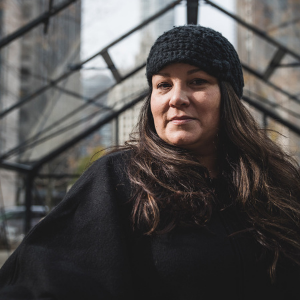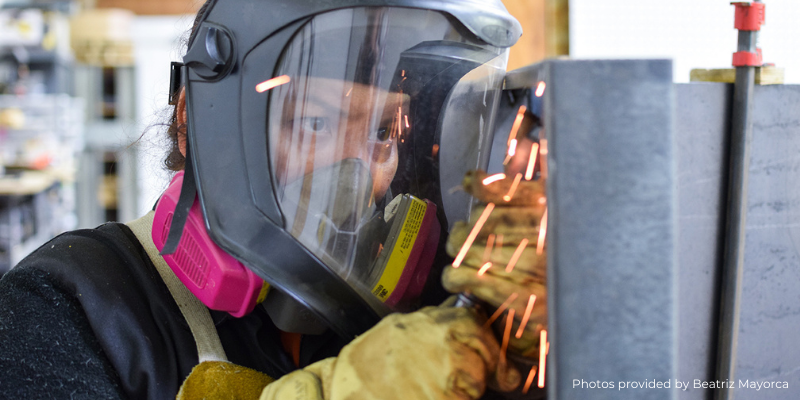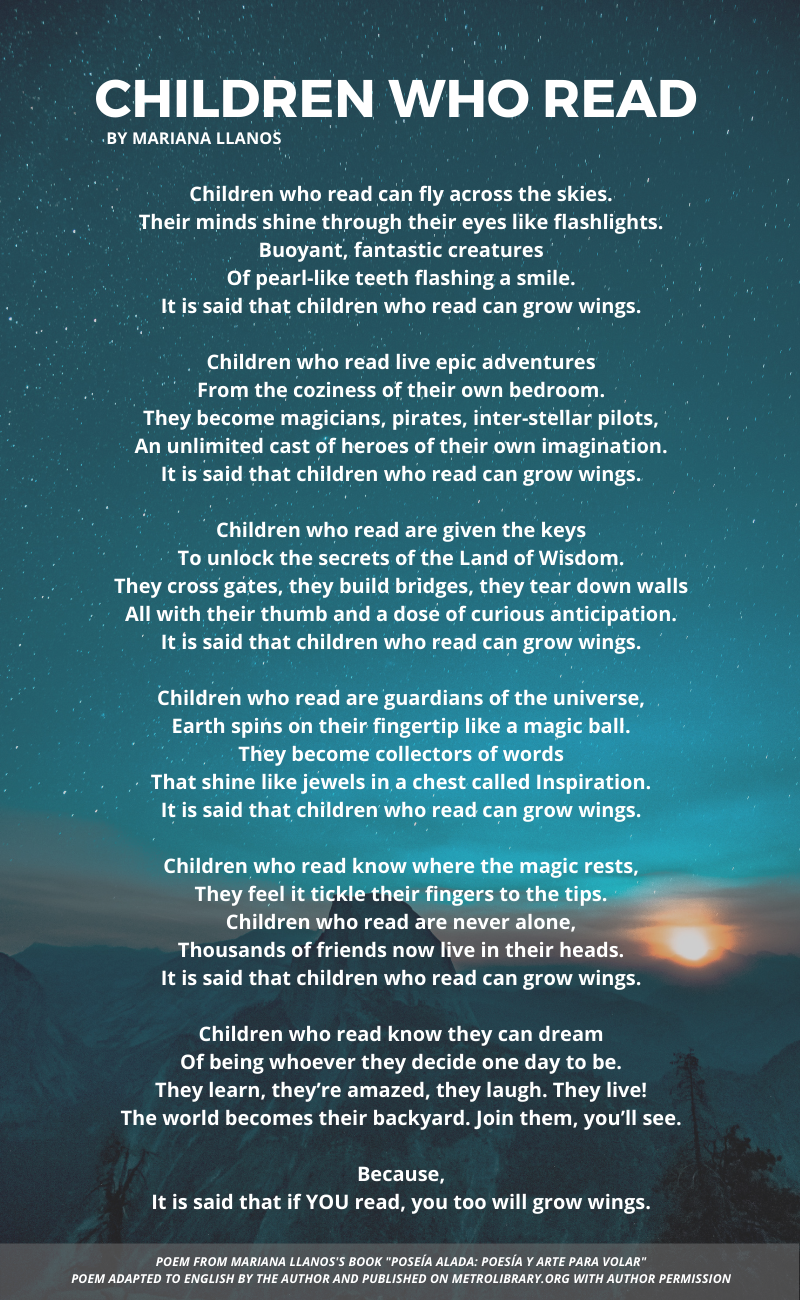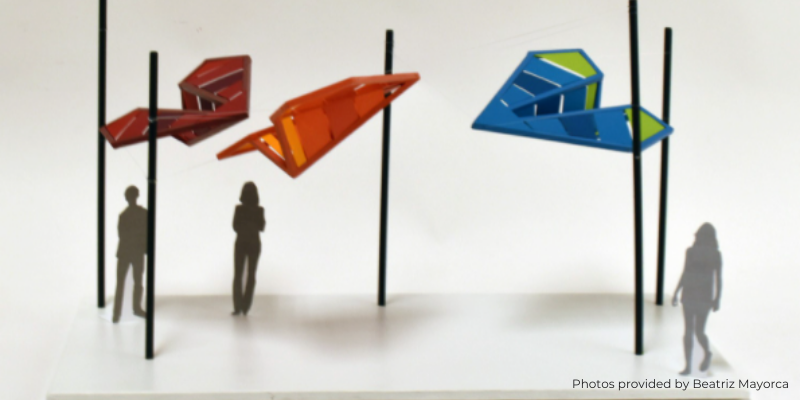
Q&A: Artist Beatriz Mayorca Shares Her Inspiration for Capitol Hill Library Sculpture
by Morgan, Marketing and Communications
Books. Lots and lots of library books.
That was the first step for local artist Beatriz Mayorca in researching her new art installation at the Capitol Hill Library. Her brightly colored — and seriously heavy duty — origami airplanes soar overhead as customers pass in and out of the library.
I got a chance to talk with Mayorca shortly after she installed her piece in 2020, and she said the library is the first place she turns to when researching a new project. (You really can’t pay for press that good.)
She's a Venezuelan-born artist armed with degrees in social communication from the Central University of Venezuela and fine arts from the University of Central Oklahoma, along with an affinity for power tools — hence the lively metalwork she creates to add interest to some of our favorite public spaces. She took a few minutes away from ideating interesting artwork to tell us more about herself, the inspiration for the Capitol Hill art installation and her vision for local art throughout our county.
Metro Library: What was your introduction to art like?
Mayorca: My family has always been drawn to art, but mostly painting and music, and I grew up watching my grandma paint and work with fabric. I always had that appreciation. When I came to the United States in 2005, I decided to go back to college and studied interior design. That program had a lot of art classes, and in taking those classes, I felt a complete passion for it. When we worked with sculptures, I was like a kid in a candy store — I never wanted to leave. So, when I studied art, I focused on sculpture.

Metro Library: What piqued your interest about sculpture in particular?
Mayorca: Working with the different materials and the power tools. It’s the same thing when I go into any hardware store. My eyes are immediately drawn to the power tools. I love them. For as long as I can remember, I’ve been the type of person who loves putting things together. As a little girl, I was always fixing all the broken things in my house.
Metro Library: Has the Metropolitan Library System, or any other library, helped you in your creative pursuits?
Mayorca: One hundred percent. Not just for this project, but for every single project, I go into the Metro Library and check out a lot of books. I’ll have so many books I have to tell my son, “You need to help me.” For this project, I learned a lot about origami: how to make it, its origin, that it’s a science people use for therapy, and that it can be used to learn a second language. I think there were at least two or three books on how to make origami airplanes alone!
In my project proposal I quoted Thomas Hull (Western New England University professor known for his expertise in the mathematics of paper folding). He talks about how origami is a technique related to many different curricula, including math, science, social science, art, language arts and therapy. It’s amazing all the things they use origami for, including STEAM classes and teaching children how airplanes fly.
I knew I wanted to create airplanes but there are a lot of origami airplanes you can make. I experimented with over 20 kinds of origami airplanes to see which worked best for the project. I needed to cover a particular square footage to create shade, but also choose something that’s easy for me to make and easy to understand for other people. I wanted something easy to relate to.
Metro Library: I love that story, that you actually used the library to make this! I think that’s so cool.
Mayorca: My dad was a college professor in Venezuela, and when I had a homework problem my dad would say “If you don’t find the answer in a book, ask me again.”
[Mayorca lifts a library book into the frame of our Zoom call, showing all her note papers jutting out.]
I love paper books. I think my eyes start getting tired of screens. I want to see, I want to touch, I want to stick notes in there.
Metro Library: Tell us about the inspiration for “Never Stop Dreaming: The Sky Is the Limit.” What did you want to convey to library customers and the Capitol Hill community with this piece?
Mayorca: They wanted the piece to relate to the library and the site history — the take-off and landing site of the first airplane in Oklahoma City. And they wanted to relate to the large Hispanic community in the Capitol Hill area. I chose origami because I wanted to create something unexpected and unique that would make people say “Wow, I knew about origami but these are metal, and they’re so big, maybe this is somewhere I can play.”
And for the library side, I chose origami because it brings together math and all the different curricula and the things we go to the library to learn about.
For the Latin community, I focused on the use of color and the freedom those colors give us. Growing up, I remember playing on the street with all the kids around my house and I remember the colors of that time. We are warm people and our culture and architecture and clothes and folk art are all about bright colors. That is why I use them.
And lastly, I felt like I needed one thing, something that ties all the ideas together, and I worked with Mariana Llanos, an artist and Hispanic writer who lives in Oklahoma City and whose books are in the library collection, and I took their book and started reading one poem. When I read the poem, I cried, like I literally cried. This is what tied it all together and how I got the name of the piece.

Metro Library: Seeing how passionate you are reading that poem, it makes me feel like this project was personal to you. Was it?
Mayorca: Yes, most of the time when I create my art pieces, there is always a concept behind it. I may have different concepts, but they need something to pull them all together. That is the thing I wanted to bring to all the people.
Metro Library: What has the reception been like now that the piece has been installed?
Mayorca: At the time of installation, since the library had been temporarily closed (because of COVID-19), what I heard from social media and what I heard when I was inside the library was “That is so cool!” and “That is so nice!” They are happy. When I see a smile because of my artwork, or a laugh because my artwork reminds them of something in their life, I love that — to see the happiness in their faces.
Metro Library: I was there for some of the installation. It seemed like a tricky process! Can you tell us about how a piece like this goes from concept to actuality?
Mayorca: A lot of hand-drafting sketch ideas accompany my preliminary research; before I jump to work I’m in AutoCAD (computer-aided design) and Rhino programs for the details and to see what's the best way to execute my best concept.
[Mayorca holds up a small model of the installation.]

When I work in CAD and 3D models, it’s not only for my clients to see it, but it helps me see how I want to build it. My pieces are very detail-oriented. For example, to create each flat color on the wings, I needed to figure out specific shapes, dimensions, and angles to deliver a symmetrical arrangement. I spent a lot of time in two different computer programs, working on paper too, figuring out those details. Creating this public art piece also implies a lot of work with the community, with the library representatives, the city, the engineers, contractors and suppliers. Public artists need to be open to working with all these different people. Most of the time, artists are working on their own, painting or creating a sculpture to sell, but the field of public art is more about community, collaboration and teamwork. Even though your name is on it, it was possible thanks to all the collaboration between all those people.
Metro Library: Who or what inspires you?
Mayorca: Nature is one thing that really inspires me. I am glad that where I live, I can go outside and appreciate the nature surrounding me.
In art, modern architecture and contemporary architecture really inspire me. For instance, the architecture of the Ciudad Universitaria de Caracas (Central University of Venezuela) is one of my main inspirations. When I went to college there, I had the extraordinary opportunity to appreciate how the art can be inlaid into the buildings themselves to create beauty and functionality at the same time. One example is the "Clouds" by the American artist Alexander Calder. They are elliptical and colorful shapes that float and cover the walls and ceiling of the Aula Magna, not only to create architectural interest but also to serve as acoustic control. Examples like this one are all over the campus and are the reason this university was included in UNESCO's list of World Heritage sites.
Metro Library: How important is continual learning and experimentation when it comes to your artwork? How do you prioritize that?
Mayorca: For me, it’s extremely important. I need to learn what is out there and improve my craftsmanship. I need to practice, learn new techniques, learn new materials. You need to work and experiment and practice. And read. If I go to create public art for a park, I read about the meaning of public art in parks. Keep learning and practicing and trying to improve your skills.
!["[EVOLVE] Sculptural bike racks group at McKinley Park, OKC "](/sites/default/files/2021-05/Dog-Eared%20Blog%20Graphics%20800x400%20%283%29.png)
Metro Library: Do you have more artwork on display in Oklahoma County currently? Where can we see it?
Mayorca: A few years ago, I created the park benches at High Tower Park, near the Downtown Library. I created a group of bike racks at McKinley Park, and designed a bike rack that is in Campus Corner in Norman. You can also find a light sculpture I created in the GE Research Center in Oklahoma City.
Metro Library: If you could influence the art scene around Oklahoma County in one way, or change a common perception about local art or local artists, what would that be?
Mayorca: I would make the private sector more open and receptive to artists or include artists in the architectural design of buildings. I also want people to learn more about the importance of bringing art to the community. Art is iconic. When you think about Paris, the first thing that comes to your mind is the Eifel Tower. It creates community dialogue; the arts help to build relationships, create memories. When it is included in the urban design itself, it also helps to improve our social capital, bring innovation; it serves to reshape spaces that were forgotten or unsafe. They're tons of examples around the world where art and public art improved the safety and well-being of people in general.
I feel art is very important to bring people together. You can speak different languages, but you understand the language of art, you understand the language of music, you understand the language of poetry.
Metro Library: What advice do you have for others who want to work in the world of art?
Mayorca: Learn, be curious, and look for classes or books — there are so many available. Practice a lot and be persistent. Art is not an easy career in any part of the world, and it takes a lot of persistence.
Metro Library: If library customers want to learn more about you and keep up with your work, what’s the best way to do that?
Mayorca: Visit my website. There, you can sign up for my mailing list to keep up with new events and projects. You can follow my work on Instagram too at @bmayorca.
Now that you know all about the artist who created Capitol Hill Library’s vibrant overhead art installation, swing by soon and see it for yourself! The Capitol Hill Library is located at 327 SW 27th St., Oklahoma City.